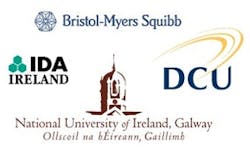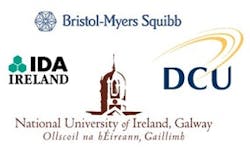IRELAND IS CURRENTLY at the forefront of exciting change within the global Research and Development (R&D) community. As the European Union boosts its R&D spending, it is increasingly turning to corporate alliances (see "Europe Drives Collaborative R&D" below) to drive applied research.
In synch with these efforts, Ireland is making some bold moves to bolster its research base. This year, the Irish government spent €3.8 billion on new programs to improve the R&D infrastructure, attract more graduates to scientific and technical fields, and promote corporate-academic research alliances.
Within this context, the Center of BioAnalytical Sciences (CBAS) (see "Staffing for Success in an Industrial-Academic Partnership" below) was launched in September 2005, after nearly three years of hard work by Dublin City University, National University of Ireland, Galway, Bristol-Myers Squibb (BMS) and The Irish Industrial Development Agency (IDA).
The Center’s mandate is to develop novel capabilities in the field of bioanalytical characterization through the use of hyphenated analytical techniques and novel analytical platforms. The analytical systems developed would be generic, and could be customized and applied to any biomolecule or process. The two universities involved in the Center will control intellectual property resulting from this research, so that, in the future, the results of the Center’s work would be available to any company anywhere in the world.
CBAS will be focusing on glycosciences, studying sugars — specifically, the glycans that play such an important role in biological pathways. Five interconnected projects, three in Dublin and two in Galway, will be carried out at the Center focusing on:
- Media characterization, with the goal of improving biofermentation;
- Product monitoring during cell culture.
Currently, there is no real way to assess the quality of the media used to feed cells. Ideally, each medium should be characterized before and after mixing, and at various points during production.
Similarly, during cell culture, there has been no way to monitor carbohydrate profiles of the bioproduct. For example, any given protein may have three oligosaccharides attached but 20 different structures or isoforms, each of which will have a different activity. In an ideal situation, a protein would be harvested when carbohydrates contained the best distribution of isomers.
Research into bioanalytics is the only way to advance the state of the science which, so far, has failed to keep pace with breakthroughs in genomics, robotics and automation. Changes can arise at scale up, when a new raw material vendor is used, or for regulatory purposes, and today’s instrumentation cannot always detect these changes, resulting in waste. In addition, current spectroscopic analysis makes it difficult to distinguish between secondary and tertiary structural information.
Improved bioanalytics will reduce time to market
As more companies develop biological therapeutics, the world’s regulatory agencies are going to rely on more analytical evidence of biocomparability and other factors. Availability of new analytical methods would help more companies bring biotherapies to market more easily, simplifying a process that is currently far more complex than that for small molecules.
Already, the European Medicines Evaluation Agency (EMEA) [3], expects manufacturers to be able to demonstrate comparability between pre- and post-change medicinal products that contain biologically derived proteins as active ingredients.
Due to the limitation of existing analytical technologies, demonstrating absolute comparability requires using various analytical techniques, and even clinical trials. It may only be a matter of time before the Food and Drug Administration (FDA) introduces similar guidance into regulation.
BMS’s corporate leadership recognizes the fact that generic bioanalytical platforms will be essential to commercializing new biopharmaceuticals in the future, and that input from diverse sources can only improve the outcome. Thus, the Center welcomes inquiries from biopharmaceutical manufacturers, raw material suppliers and analytical instrument developers that can help maximize the potential application of this research.
CBAS’ launch coincided with BMS receiving approval to manufacture Orencia, the company’s first fully in-house-developed biologic for the treatment of rheumatoid arthritis. BMS plans to build upon this success by developing more active pharmaceutical ingredients derived from biotechnological sources.
Some of the drivers behind BMS’ decision to partner in this venture are in synch with changes in R&D directions at many large pharma companies. They include:
- Increased focus on biotechnology;
- Leverage of strategic partnerships — either with other pharmaceutical companies or third-party manufacturers;
- Development of parallel strategies for small molecules and biopharma, to improve business models and increase market share in both areas.
The company plans to build a large-scale bioprocessing facility in Devens, Mass., clearly supporting its commitment to industrial-academic research. Future managers and operations staff will come to the industry with a strong pedigree and the skills sets required for success in what is and will remain a high-tech industry.
Each stream of research was specifically selected, since it is linked to or overlaps with at least one other project stream. In Galway, for example, the first stream, headed by Professor Angela Savage and Dr. Marian Kane, is working to generate reference materials, primarily oligosaccharides and glycoproteins, and to validate rapid analytical methods using biochips and mass spectrometry.
Advanced analytical platforms
The team is applying advanced analytical platforms such as Surface Enhanced Laser Desorption Ionization (SELDI) to N’- and O’-linked oligosaccharides, and applying mass spectrometry, NMR and array-based proteomic systems for glycan analysis.
A second team at Galway, led by Dr. Alan Ryder, is looking at using X-ray fluorescence to characterize raw materials and feedstocks. The team is also applying spectroscopic techniques, both traditional and nonreagent analysis, such as dispersive Raman and NIR (both planar and probe) in real-time, in-process analytical detection systems.
The goal is rapid analysis of fermentation mixtures and their precursors. Right now, the group is focusing on “at-line” systems, but they might possibly be developed for “in-line” processing in the future.
At Dublin City University, a team led by Dr. Brendan O’Connor and Dr. Michael O’Connell is focusing on identification and characterization of lectins, which in turn can characterize oligosaccharides and glycoproteins, both critical for optimizing biological drugs’ delivery and bioavailability.
Their team is expressing and purifying new lectins, using traditional techniques, but is also characterizing them via Matrix Assisted Laser Desorption Ionization (MALDI) mass spectroscopy, leveraging quadropole time of flight (Q-TOF) instrumentation.
Another Dublin team, led by Professor Brian MacCraith and Professor Richard O’Kennedy, is focusing on the role that sialic acid plays in biosynthesis and drug efficacy. They are exploiting advanced technologies in optics platforms, using them with immobilization technology to develop highly specific detection systems.
Applying microfluidics at the nano scale
The third Dublin team, as well as colleagues in Galway, are looking at the use of microfluidics and advanced two-dimensional chromatographic separations at the nano scale. Its goal is to determine how such systems could be micro-fabricated into lab-on-a-chip technology and hyphenated to Q-TOF mass spectroscopic platforms. Leading this team are Dr. Brett Paul with Professor Dermot Diamond and Dr. Donal Leech. Using these techniques, separations would take minutes, rather than hours.
Clearly, these are exciting times for R&D and the field of bioanalytics, particularly as the industry moves to in-process testing applying Process Analytical Technologies (PAT). As CBAS celebrates its first anniversary, much has been achieved, but much more is yet to come.
References
1. European Medicines Evaluation Agency ICH Topic Q5E ‘Comparability of Biotechnological/Biological Products’ CPMP/ICH/5721/03 - June 2005
2. ‘Statistics in Focus’: Science and Technology Author Simona: Frank Eurostat 6/2006.
3. http://www.entemp.ie/publications/science/2006/sciencestrategy.pdf
About the Authors
Declan Moran is the Bristol-Myers Squibb Senior Scientist embedded at the Dublin University campus. A graduate of Dublin City University, Moran has spent the last 16 years working in analytical development for Bristol-Myers Squibb.
Professor Dermot Diamond is Director of CBAS. He received his Ph.D. from Queen’s University Belfast (Chemical Sensors, 1987), and was vice president for Research at Dublin City University, Ireland (2002-2004). He has published over 150 peer-reviewed papers in international science journals and is a named inventor in 12 patents. He joined DCU in 1987 as a member of the School of Chemical Sciences, and was a founding member and director of the Biomedical and Environmental Sensor Technology (BEST) Center.
Professor Terry Smith is Director for the National Center for Biological and Engineering Sciences (NCBES) at the National University of Ireland, Galway. He obtained his Ph.D. from Oxford University in 1988, and then spent two years as a research fellow at the University of North Carolina at Chapel Hill. He returned to Ireland in 1990 to join the National Diagnostics Center of Bioresearch Ireland. A founding member of the NCBES, he was appointed its director in 2002.
Staffing for Success in an Industrial-Academic Partnership
The Center is located on two Irish campuses, at Dublin City University and the National University of Ireland, Galway, involving 32 researchers from very different backgrounds with diverse skill sets. Interestingly, as part of the terms and conditions of the private-public agreement, Bristol-Myers Squibb (BMS) has embedded seven of its employees, who are permanently located on the research campuses in Dublin and Galway.
There is scope to extend the collaboration beyond that, with other public funding and discretionary support of BMS, and, perhaps, other interested industrial partners. Allied to the Center’s establishment, BMS aims to help fund the creation of two Scientific Chairs, one at each university, in collaboration with Science Foundation Ireland. It is hoped that these chairs will aid in the universities’ basic research interests, but also inform their basic research programs through knowledge of applied research and industrial trends.






